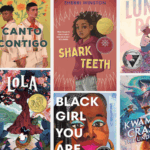A new calendar year is an exciting time for a fresh start, but it’s also a challenging time to be a teacher. Remember, it’s up to you to keep your students engaged in the classroom post-holidays — so why not make it fun? As you prepare for the aftermath of winter break this year, here are some tips and activities for surviving the season and reviving yourself and your students.
1. Provide Time for Sharing
Students are excitable, energetic and distracted this time of year — because they’re thinking about all the fun they had over the holidays, and they might not feel quite ready to concentrate again. Instead of trying to get them to focus when their attention is scattered, set aside some time to share as a class. Did anyone go on a trip over winter vacation? What are your students’ holiday traditions?
It’s a good idea to have some sharing sessions even after school starts up again for the season. In December, you may have talked about what your students were looking forward to. When they come back in January, start a discussion about their favorite part of their time off.
Relationship-building creates a more inclusive and respectful educational climate. You’re not wasting valuable teaching time — you’re establishing a classroom culture where behavioral and focus problems don’t interrupt learning.
2. Have Students Set New Year’s Resolutions
The post-holiday season is a great time to teach your students about goal-setting — a valuable life habit they can learn to hone. Setting ambitious but specific goals is a skill that will drive students to succeed through school and into their college years.
A New Year’s resolution is the perfect start to smart goal-setting. Refocus your learners by having them create a S.M.A.R.T. goal for school or learning. Teach them to include the following elements:
- Specific: Students are more likely to attain their goals if they’re narrow in focus. Maybe Sierra wants to improve her language arts grade one level.
- Measurable: How will learners measure their progress? By their grades? By the number of questions marked correct on assessments? Teach them to make sure their goals are measurable.
- Attainable: Have students outline the specific steps they’ll take to reach their goal. They could commit to studying for 15 minutes more per week, for example, or they could work on better listening behavior during one lesson each day.
- Realistic: Encourage children to create goals they can realistically attain. It’s great to be ambitious, but each student should also feel confident in their abilities, so setting manageable goals can help them achieve more over time.
- Timely: Create a time frame for achieving the goal. Short-term goals could include getting an A on the weekly spelling test. A longer-term goal might be creating a project portfolio or researching a report.
3. Make Time for Reading
If you teach at the elementary level, have your students curl up on the rug while you read them a winter story. If your students are older, bring back the practice of sustained silent reading.
Escaping into a story is a great way to give students a break from instruction while getting them refocused. Plus, reading aloud builds critical skills as students grow. Just 10-30 minutes of reading can increase comprehension and help students regain their attention span, especially if they spent most of their break on electronic devices.
4. Give Creative Writing Prompts
Offer your students an enjoyable outlet by giving them creative writing prompts about the holidays. These prompts should encourage open sharing, tell a personal story or imagine a scenario. Some ideas for getting students interested could include
- What are your favorite holiday traditions, and why? Describe them in detail.
- What are you looking forward to doing this year?
- What person did you love spending time with over break, and what did you do together?
- What is your favorite holiday food, and why do you enjoy it so much?
Engaging your students in creative writing is a great way to help them hone their expressive skills and vocabulary, and providing prompts about the holidays allows them to process their recent experiences in an academic way.
5. Start an Art Activity
Many students gravitate toward artistic activities. Even learners who doubt their drawing or painting ability love activities like creating collages or other expressive outlets. Encourage your learners to bring some of their own supplies for personal winter crafts — like leftover wrapping paper, candy canes or cotton balls — and see what winter masterpieces your classroom can create. Winter art projects are a great activity to keep kids excited after the break.
6. Establish Morning Meetings
Morning meetings let you check in with your students and give them a safe time for sharing. The daily message sets the tone for what they’ll learn that day and establishes expectations. Brief, lively activities also encourage group cohesion.
7. Rearrange the Furniture
Little changes are a big deal for students. Revitalize their interest in learning by rearranging your furniture. If you formerly had desks arranged in groups of two, create larger pods of four. Opt for a circular arrangement instead of rules. Provide surprises — hang a new poster under an old one, and accidentally “bump” the old one, revealing the updated artwork.
8. Manage Your Expectations
Finally, keep your expectations in check. It’s better to have realistic expectations after the holiday season, and understand that your students might not always be on their best behavior.
While the time after winter break is a great chance to bring in new classroom strategies and get creative with your students, don’t be disappointed if your plans don’t hush the room as much as you’d hoped. This is an opportunity to get to know your students better and enjoy the new year together — so have fun!








